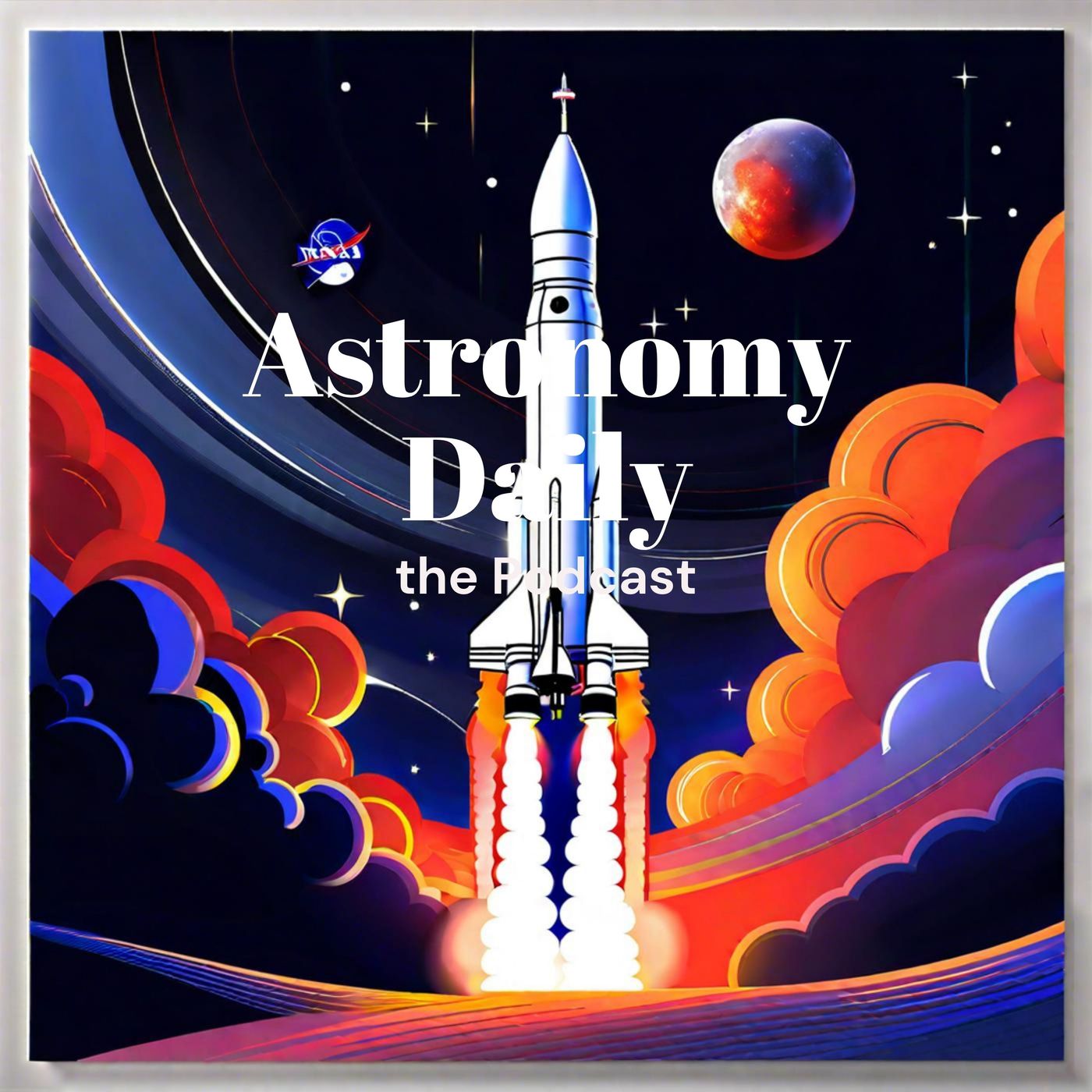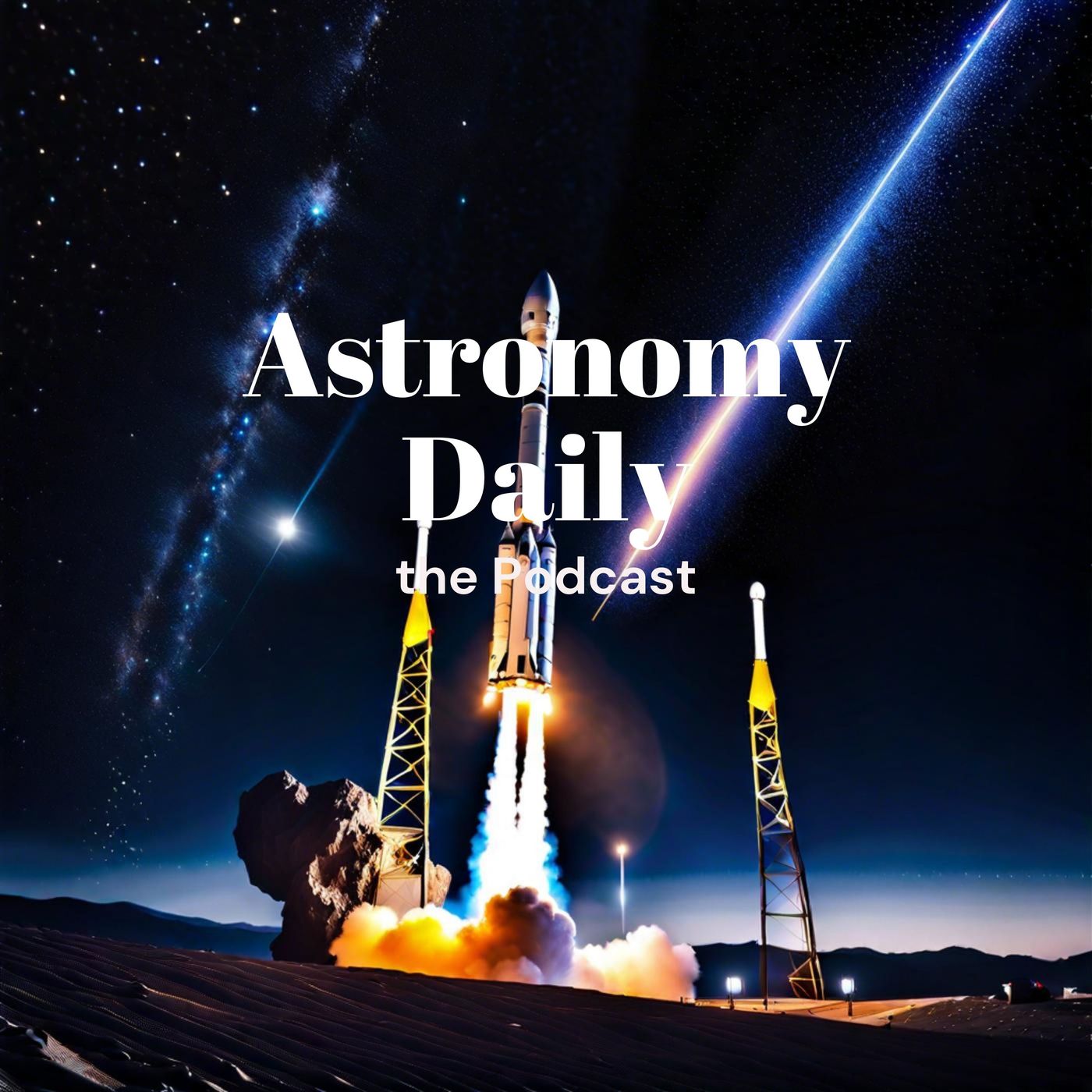S03E134: Ancient Galaxies Unveiled, DART Debris Mystery, and Polaris' Hidden Spots
Welcome to Astronomy Daily. I'm Anna, your guide on this cosmic journey. Today, we have a thrilling lineup of stories straight from the universe's farthest reaches. We'll dive into the discovery of ancient galaxies that shed light on the early...
Welcome to Astronomy Daily. I'm Anna, your guide on this cosmic journey. Today, we have a thrilling lineup of stories straight from the universe's farthest reaches. We'll dive into the discovery of ancient galaxies that shed light on the early universe, explore potential debris from NASA's DART mission making its way to Earth and Mars, and unveil stunning new images of Polaris, our North Star. We'll also decode the legendary WOW signal and discuss how longer Earth Daily influenced evolutionary milestones. So sit back, relax, and let's embark on this incredible voyage through space and time.
- **Ancient Galaxies Discovered by China's FAST Telescope**: Astronomers using China's FAST telescope have made a groundbreaking discovery—six ancient galaxies teeming with hydrogen. This significant finding not only advances our understanding of the early universe but also highlights the extraordinary potential of modern radio telescopes.
- **NASA's DART Mission Debris**: NASA's DART mission, which stands for Double Asteroid Redirection Test, made headlines when it successfully demonstrated a strategy for deflecting potentially hazardous asteroids using the kinetic impact method. On September 26, 2022, the DART spacecraft collided with Dimorphos, showcasing how we might protect our planet from future asteroid threats.
- **Stunning New Images of Polaris**: Thanks to advancements in telescope technology, recent high-resolution images of Polaris, our North Star, have unveiled a deeper layer of its complexity. Captured by the CHARA Array on Mount Wilson in California, these images reveal large, bright, and dark spots on Polaris' surface, similar to sunspots.
- **Decoding the WOW! Signal**: In 1977, the intriguing WOW signal, a powerful and narrow-band radio signal, was detected by the Ohio State University's Big Ear radio telescope. For decades, the source of this signal remained a mystery. However, recent research led by Abel Mendez from the University of Puerto Rico at Arecibo suggests that the WOW signal was likely caused by the transient brightening of hydrogen clouds in space.
- **Longer Earth Days and Evolutionary Milestones**: Recent studies have revealed a correlation between the moon's gradual departure from Earth and the lengthening of our planet's Daily. As the moon drifts away, it siphons off Earth's rotational energy, causing our planet's spin to slow and our Daily to lengthen. Over millions of years, these changes have added up, with days becoming more than 2 hours longer.
For more Astronomy Daily, including our continually updating newsfeed, visit our website at astronomydaily.io.
Follow us on social media at AstroDailyPod on Facebook, X, YouTubeMusic, and TikTok. We love engaging with our community, so be sure to drop us a message or comment on your favorite platform.
For more Space and Astronomy News Podcasts, visit our HQ at www.bitesz.com.
Become a supporter of this podcast: https://www.spreaker.com/podcast/astronomy-daily-the-podcast--5648921/support.
Stay curious, keep looking up, and join us next time for more stellar insights and cosmic wonders. Until then, clear skies and happy stargazing.
Sponsor Link:
https://www.bitesz.com/nordpass
Welcome to Astronomy Daily! We have a diverse lineup of stories today
Anna: Welcome to Astronomy Daily. I'm Anna, your guide on this cosmic journey. Today, we have a thrilling lineup of stories straight from the universe's farthest reaches. We'll dive into the discovery of ancient galaxies that shed light on the early universe, explore potential debris from NASA's dart mission making its way to Earth and Mars, and unveil stunning new images of Polaris, our north star. We'll also decode the legendary wow signal and discuss how longer Earth Daily influenced evolutionary milestones. So sit back, relax, and let's embark on this incredible voyage through space, space, and time.
Six ancient galaxies teeming with hydrogen discovered using China's fast radio telescope
Astronomers using China's fast telescope have made a groundbreaking discovery, six ancient galaxies teeming with hydrogen. This significant finding not only advances our understanding of the early universe, but also highlights the extraordinary potential of modern radio telescopes. These galaxies, identified by Dr. Zdeněk Sekanina Hongwei Xi and his team from the national astronomical observatories of the Chinese Academy of sciences naochemenous, contain vast quantities of atomic hydrogen gas. This is a stark contrast to the tens of thousands of galaxies previously surveyed, indicating that 4 billion years ago, galaxies held much more star forming gas than those we see today. The discovery was part of the fast Ultra deep survey, underscoring the sensitivity of the 500 meters aperture spherical radio telescope, or fast, located in Gizhou province, China. So far, over 100 new galaxies, up to 5 billion light years away, been discovered through this survey, and the final count is expected to surpass 1000. Identifying the optical counterparts of these distant radio discoveries turned out to be quite a detective story, given their faint appearance due to the immense distances. Using some of the largest optical telescopes in the US and Russia, the team was able to pinpoint these counterparts, finding that they contain two to three times more stars than our Milky Way, but about ten times the mass of hydrogen gas. This discovery also illustrates the power of international collaboration, as radio astronomers from China and Australia work together, it paves the way for future observations with upcoming radio telescopes such as the International Square Kilometer Array Observatory scow promising even more astonishing insights into the cosmos.
NASA's DART mission produced significant amount of asteroid debris
Next. NASA's DART mission, which stands for double asteroids redirect test, made headlines when it successfully demonstrated a strategy for deflecting potentially hazardous asteroids by using the kinetic impact method. On September 26, 2022, the DART spacecraft collided with dimorphos, a small moon orbiting the larger asteroid didymos, showcasing how we might protect our planet from future asteroid threats. However, while this technique proved effective in altering dimorphos trajectory, it also produced a significant amount of debris. This ejecta could potentially reach both Earth and Mars within a decade, opening up a unique opportunity for scientists to study new meteor showers. A, recent study conducted by an international team of scientists explored the fate of this debris. Using data from the light italian cubesat for imaging of asteroids, which accompanied the Dart mission. The researchers ran dynamic simulations to track the millions of particles generated by the dart impact. These simulations revealed that some of the fragments could travel to Mars in about 13 years and to Earth in as little as seven years, depending on their velocities. What's particularly fascinating is that if these particles do make their way to Earth's atmosphere, they are expected to disintegrate harmlessly, creating luminous streaks across the sky, essentially a new meteor shower generated by human activity. This phenomenon, tentatively dubbed the dimorphids, could be observed in ongoing and future meteor observation campaigns. While these tiny fragments pose no risk to us, their study offers valuable insights. Monitoring the behavior and impacts of this debris could refine our understanding of how asteroid deflection missions affect both the target asteroids and the surrounding space environment. It also underscores the importance of continued vigilance and innovation in planetary defense strategies.
New high resolution images of Polaris reveal previously hidden features
Polaris, the North Star, has long been a celestial guidepost for navigators and astronomers alike. But recent advancements in telescope technology have unveiled a deeper layer of its complexity. Thanks to the work done by the Chara array, located on Mount Wilson in California, we've managed to capture high resolution images of Polaris that are quite revolutionary. This array consists of six telescopes working in unison, effectively creating a single powerful viewing instrument with a remarkable diameter of 330 meters, or approximately 1083ft.
Anna: What this means is unprecedented clarity and.
Anna: Detail in the images produced. For years, we've seen Polaris depicted in art and Astronomy. But these new images have revealed something we didn't large, bright, and dark spots on its surface. These spots are similar to sunspots that we observe on our own sun, and they fluctuate and move over time. This discovery is groundbreaking because Polaris is a type of star known as a Cepheid variable, characterized by its periodic brightening and dimming cycles. Typically, these variations in luminosity make Cepheid stars reliable distance markers in the universe. However, spotting surface anomalies on Polaris adds an exciting, albeit challenging, dimension to its study. Interestingly, Polaris is not a solitary star. It resides in a triple star system. And the chara array's, initial aim was to chart the orbit of its closest and faintest companion. Through this mission, it was determined that Polaris is about 46 times the size of our sun. And perhaps five times more massive than previously thought. Not only does this give us further insights into Cepheid variables, but it also opens up several enthralling questions for future cosmic explorations. In sum, the high resolution images captured by the chara array not only uncover previously hidden features of our famed north star, but also promise to propel our understanding of stellar behaviors and characteristics into new terrains. In 1977, the intriguing WOW signal, a powerful and narrow band radio signal, was detected by the Ohio State University's big Ear radio telescope while it was scanning the skies for signs of extraterrestrial intelligence. This unique signal was so unusual that astronomer Jerry Amens scribbled the word wow next to the data printout, giving the signal its famous name. For decades, the source of this signal remained one of the great mysteries in the search for alien life. However, recent research has brought us closer to understanding this signal. A team led by Abel Mendez from the University of Puerto Rico at Arecibo suggests a more down to earth explanation. According to their study, the WOW signal was likely caused by the transient brightening of hydrogen clouds in space. Such brightening can occur due to events like a magnetar flare or a soft gamma repeater, which are natural astrophysical phenomena capable of producing strong hydrogen emissions. These findings were made possible by analyzing archival data from the now defunct Arecibo radio telescope. The data collected between 2017 and 2020 revealed signals similar to the WOW signal, albeit less intense, and originating from multiple locations.
Anna: What links these signals to the 1977.
Anna: WOW signal is their striking similarity in spectral characteristics differing only in brightness. The researchers proposed that the WOW signal resulted from a rare alignment of a strong transient radiation source with hydrogen clouds. Such precise conditions are infrequent, explaining why the signal has been seen only once. According to the team, this alignment could also help in pinpointing the origin of similar signals and monitoring them for future occurrences. In conclusion, while the WOW signal was initially thought to be a potential techno signature from extraterrestrial intelligence, this recent study offers a plausible, natural explanation. By shedding light on this mystery, we can reframe our search for alien life and be mindful of these new sources of false positives in future technosignature searches. The study's findings not only demystify a, stellar enigma, but also enrich our understanding of the dynamic and transient processes occurring in the cosmos.
Long days may have played a pivotal role in Earth's biological history
Next, returning closer to home, recent studies have shed light on an intriguing correlation between the moon's gradual departure from Earth and the lengthening of our planet's Daily. As the moon drifts farther away, it siphons off Earth's rotational energy, causing our planet's spin to slow and our Daily to lengthen. Over millions of years, these incremental changes have added up, with Daily becoming more than 2 hours longer. Interestingly, this extended daylight may have played a pivotal role in Earth's biological history. Researchers propose that longer Daily could have led to significant oxygenation events, which in turn fostered an explosion of life.
Anna: These periods of increased sunlight and extended.
Anna: Day length could have affected the distribution of solar energy, temperature gradients, and overall weather patterns. One key period highlighted by the study occurs roughly between 650 million and 500 million years ago, an era known for the cambrian explosion. During this time, life on earth diversified dramatically, filling new ecological niches and leading to the complex ecosystems we observe today. This study suggests that two staircase intervals of rapidly changing rotation rates, one during the cambrian explosion and another between 340,000,200 80 million years ago, corresponded with significant environmental and biological shifts. While these gradual changes may seem modest, the cumulative effect over geological time scales is profound. The study underscores the interconnectedness of astronomical and terrestrial phenomena, revealing how the subtle dance between Earth and its moon can have far reaching impacts on life as we know it. M thank you for tuning into Astronomy Daily with Anna. It's been a fascinating journey exploring the latest wonders of the cosmos together. Remember to check out our website at astronomydaily IO for all your space news needs. There, you can sign up for our free Daily newsletter and delve into our constantly updating news. Plus, you can catch up on all our past episodes at your leisure. We also love connecting with you on social media. Follow us by searching for AstroDailyPod, Dailypod on Facebook, X, YouTubeMusic, and TikTok for more space updates, fun facts, and lively discussion. Stay curious and keep looking up. Until next time, this is Anna signing off from Astronomy Daily.
New to Astronomy Daily - The Podcast?
Here are some great episodes to start with.


















